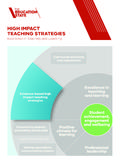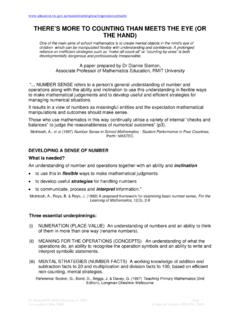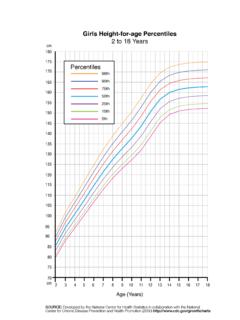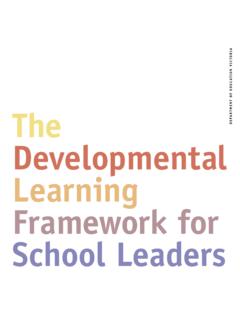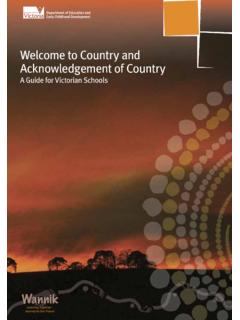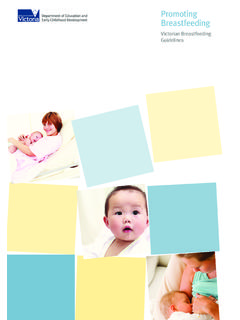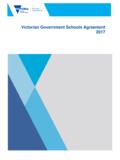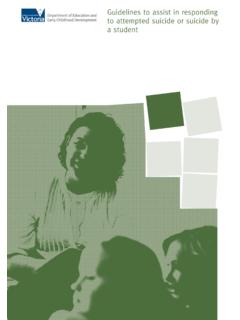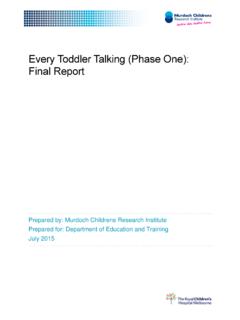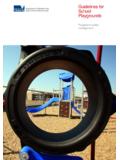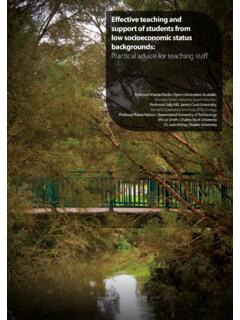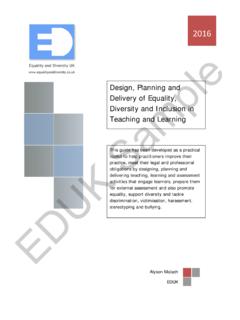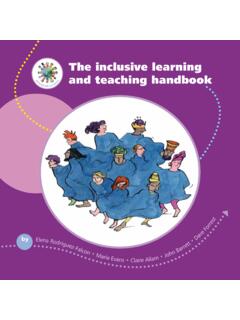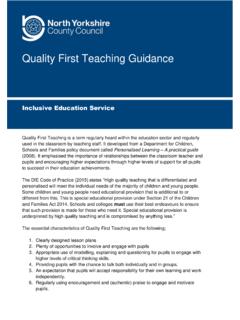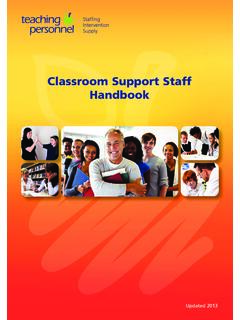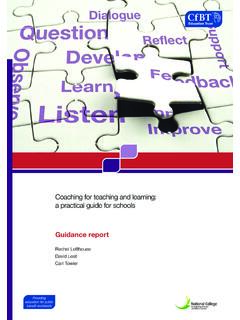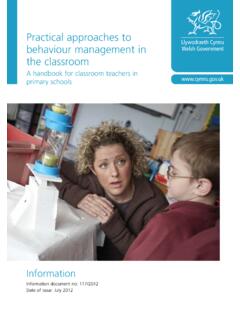Transcription of Peer Observation Feedback and Reflection Practical Guide ...
1 peer Observation , Feedback AND Reflection :A Practical Guide FOR TEACHERSP ublished by the Department of Education and Training Melbourne May 2018 State of Victoria (Department of Education and Training) 2018 The copyright in this document is owned by the State of Victoria (Department of Education and Training), or in the case of some materials, by third parties (third party materials). No part may be reproduced by any process except in accordance with the provisions of the Copyright Act 1968, the National Education Access Licence for Schools (NEALS) (see below) or with educational institution situated in Australia which is not conducted for profit, or a body responsible for administering such an institution may copy and communicate the materials, other than third party materials, for the educational purposes of the by the Department of Education and Training, 2 Treasury Place, East Melbourne, Victoria, : 978-0-7594-0833-34 | A Practical Guide FOR TEACHERSA Practical Guide FOR TEACHERS | 5 ABOUT THIS Guide 7 How these resources are structured 7 INTRODUCTION TO peer Observation 8 What is peer Observation ?
2 8 Why engage in peer Observation ? 8 The cycle of peer Observation 9 THE STAGES OF THE peer Observation CYCLE 10 Teacher self- Reflection 10 Pre Observation conversation 11 peer Observation 12 Post Observation conversation 13 REFERENCES 14 Links to other tools 14 Professional reading 14 Departmental resources 14 Templates for use during the peer Observation cycle 14 Contents6 | A Practical Guide FOR TEACHERSWe welcome your input. If you have any Feedback on the peer Observation Guide , please share your Feedback at Practical Guide FOR TEACHERS | 7 This Guide has been developed to support teachers engaging in the process of peer Observation , Feedback and Reflection . This Guide is applicable to all school contexts. peer Observation implemented under these guidelines is not to be used in any unsatisfactory performance procedure. Management of unsatisfactory performance is to be conducted under the Guidelines for Managing Complaints, Misconduct and Unsatisfactory Performance in the teaching Service.
3 The use of this peer Observation material is optional for schools. Where appropriate to the needs of the school, this Guide can support the implementation and embedding of peer Observation . How these resources are structured A Guide for principals and school leaders, which introduces peer Observation , including Feedback and Reflection , as an improvement strategy to enhance student learning. This Guide includes advice on the preconditions for successful peer Observation and how to establish a culture that enables this practice to happen. A Guide for teachers, which describes the stages and steps of peer Observation . This includes information about what each phase involves, good techniques and practices, as well as advice for both the teacher being observed and the teacher who is observing. Examples and links to further resources are also included. Tools for peer Observation : each phase in the cycle of peer Observation includes an annotated template for teachers to inform their self Reflection , pre Observation conversation, Observation , and post Observation Reflection and Feedback .
4 These tools are available on the Department s website at ABOUT THIS GUIDE8 | A Practical Guide FOR TEACHERSWhat is peer Observation ? peer Observation involves teachers observing each other s practice and learning from one another, focusing on teachers individual needs and the opportunity to both learn from others practice and offer constructive Feedback to peers. peer Observation aims to support the sharing of practice and builds self-awareness about the impact of one s teaching practice in order to affect peer Observation is a structured and negotiated way of teachers working together to refine and improve their practice, and can support teachers to enhance student learning when situated in a broader culture of collaboration, mutual trust and respect. To be successful, peer observations must have a specific focus, for example, lesson structure or the articulation of lesson Whole-school protocols and preconditions support peer Observation to be structured and ensure that outcomes for staff and students are maximised.
5 The Victorian Government Schools Agreement 2017 requires that arrangements for collaboration, peer Observation including Feedback and Reflection , and coaching are the subject of consultation. To this end, school leaders should establish protocols, procedures and structures that support peer Observation as a core part of school-based professional learning, using the school s agreed consultative Observation is a developmental opportunity for Australian Institute for teaching and School Leadership (AITSL) How-to Guide : peer Observation DuFour, R., & Eaker, R. E. (1998), Professional learning communities at work: best practices for enhancing student achievement. Bloomington, Ind.: National Education Service; Alexandria, Va. ASCD, Australian Institute for teaching and School Leadership How-to Guide : peer Observation engage in peer Observation ? peer Observation enables teachers to build their individual capability and develop a shared understanding of effective classroom practice.
6 It also allows teachers to build their capability in giving and receiving Feedback . Research shows that when done well, peer Observation , including Feedback and Reflection , has a high impact on improving professional practice and can be an important part of a teacher s professional The Victorian teaching and Learning Model (including the Practice Principles for Excellence in teaching and Learning, the Pedagogical Model and the High Impact teaching Strategies) can support teachers to determine the focus of peer observations. For example, areas of focus could include pedagogical approaches, curriculum planning, assessment strategies or opportunities for student voice and agency within the lesson. peer Observation can benefit both the teacher being observed and the observer. peer Observation can: provide opportunities to discuss challenges and successes with trusted colleagues support the sharing of ideas and expertise among teachers build a community of trust through opening classroom practice to a wider audience support a focus on improving the impact of learning4 contribute to the collective efficacy of the whole TO peer OBSERVATIONV ictorian teaching and Learning ModelCurriculum planning and assessmentEvidence-based high impact teaching strategiesEvaluating impact on learningParents and carers as partnersGlobal citizenshipNetworks with schools, services and agenciesBuildingcommunitiesBuilding practiceexcellenceExcellence in teaching and learningPositive climate for learningProfessionalleadershipCommunity engagement in learningStudent achievement.
7 Engagement and wellbeingEmpowering students and building school prideHealth and wellbeingSetting expectations and promoting inclusionIntellectual engagement and self awarenessInstructional and shared leadershipStrategic resource managementVision values and cultureBuilding leadership teams Pedagogical ModelEngageExploreExplainElaborateEvalua te1. High expectations for every student promote intellectual engagement and self-awareness2. A supportive and productive learning environment promotes inclusion and collaboration3. Student voice, agency and leadership empower students and build school pride4. Curriculum planning and implementation engages and challenges all students5. Deep learning challenges students to construct and apply new knowledge6. Rigorous assessment practices and Feedback inform teaching and learning7. Evidence-based strategies drive professional practice improvement8.
8 Global citizenship is fostered through real world contexts for learning9. Partnerships with parents and carers enhance student learningPractice Principles*Vision for LearningAll students are empowered to learn and achieve, experiencing high quality teaching practice and the best conditions for learning which equip them with the knowledge, skills and dispositions for lifelong learning and shaping the world around themHigh Impact teaching Strategies1. Setting Goals2. Structuring Lessons3. Explicit Teaching4. Worked Examples5. Collaborative Learning6. Multiple Exposures7. Questioning8. Feedback9. Metacognitive Strategies10. Differentiated teachingVictorian teaching and Learning Model*The Victorian Early Years Learning and Development Framework (VEYLDF) is an essential resource for primary school teachers. Abilities Based Learning and Education (ABLES) is an essential resource for specialist school Practical Guide FOR TEACHERS | 9 Teachers learning from one another, building a shared understanding of effective practice Self- Reflection informs future peer Observation activitiesUnderpinned by supportive and collaborative whole-school protocols and developmentalapproach Provides an opportunity for structured Feedback and Reflection , based on agreed criteria with a focus on progressing student learningImplementation of new strategies and improved teaching and learningTeacher self-reflectionPre Observation conversationPeer observationTeacher and observer reflectionPost Observation conversationThe cycle of peer Observation The cycle of peer Observation provides a basis for the implementation of peer Observation , Feedback and cycle includes the key phases for successful peer Observation .
9 Which supports improvements in teaching practice and student learning. The cycle of peer Observation Successful peer Observation is built on a culture that is respectful, trusting and Observation should be focused on an agreed aspect of learning and teaching practice (such as the Practice Principles or the HITS) and be planned, scheduled and aligned with school improvement priorities. Protocols, procedures and structures that support peer Observation should be established prior to observations taking Observation is a developmental opportunity for teachers. peer Observation should be implemented via a staged approach where teachers have opportunities to reflect and adjust processes over observations can occur between two teachers, or within teams such as professional learning communities, if agreed by | A Practical Guide FOR TEACHERSSelf- Reflection a valuable opportunity for the teacher being observed to consider areas of their practice that might be the focus of the Observation .
10 The self- Reflection process provides opportunities for the teacher to consider how whole-school priorities might link with their selected focus, to maximise shared learning experiences and support student learning. Self- Reflection supports the teacher being observed to consider influences which might restrict their experience of peer Observation , Reflection and Feedback . Self- Reflection is for other colleagues to influence or direct the teacher to focus on an aspect of their practice. Self- Reflection is not a collaborative opportunity, unless the teacher requests input or Feedback . Initial self- Reflection may not necessarily align with whole-school improvement initiatives. Example situationCarolyn is an experienced teacher with 11 years of classroom teaching in primary schools. This year she started at a new school and is not familiar with their whole-school instructional model or the focus areas for improvement in the School Strategic Plan and Annual Implementation Plan.
